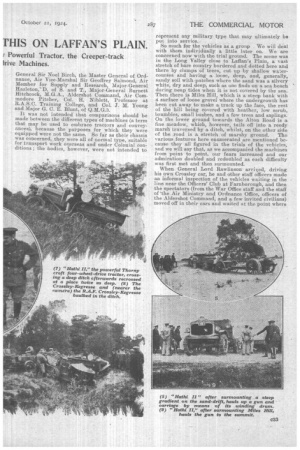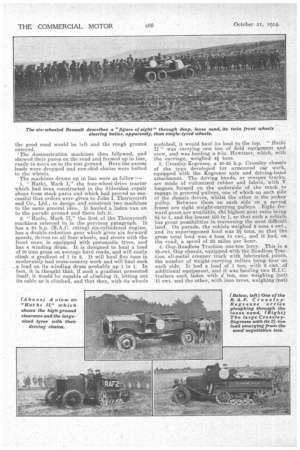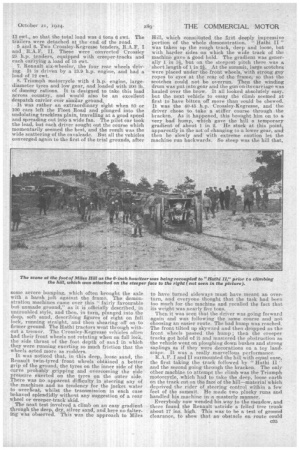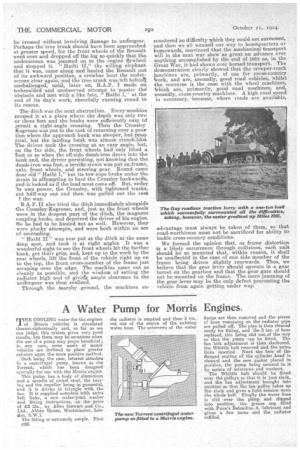WITH THE OONTS AND T
Page 16

Page 17

Page 18

Page 19

Page 20

If you've noticed an error in this article please click here to report it so we can fix it.
THIS ON LAFFAN'S PLAIN. AFTER a day spent in the company of the tractors and vehicles which are being developed for military purposes by the mechanical transport section of the War Office, we wanted to sit down and write the story of the oont and hathi, but we were faced with a small difficulty‘ We could recognize the analogy of the hathi, for the two powerful tractors on pneumatic tyres developed by the Aldershot Command have been named respectively " Hathi, Mark 1," and " Hathi, Mark II," and truthfully live up to their name, for they have all the attributes, the strength,' the cheerful good-heartedness, the superb and sublime willingness of the elephant. For their companions in the day's trials, the creeper-track vehicles, however, the appellation " oont " did not seem altogether suited, and so we felt a measure of hesitation in employing it: They ploughed the sands of the desert at Farn. borough oheerfully enough, but they had developed no htimp (although they carried their water supply in their jackets), and they did not smell like camels. But, in India and other lands where wild country predominates the new productions of the mechanical transport section will veritably be the oonts and the hathis of the Army.
What had been arranged had been a demonstration of the capabilities of these machines, all of which, let it be noted, had not, been designed entirely for military cross-country purposes, but they were required to show, within the possibilities of the Aldershot district, that they could leave the high road and pass over loose, deep soil, marshy land and obstrue • tions, could climb steep hills, and generally accomplish work which, in the past, had been considered only suitable. for horses. If they proved this, then the mechanicalization (a long but expressive ward) at the Army's transport could be pursued with confidence.
There was a tremendous gathering of officers at the rendezvous on a glorious late summer afternoon, but it was on the arrival of Gen. Lord Rawlinson, Commander-in-Ghief (India), and Lt.-Gen. Sir Alexander Cobb, Military Secretary to the India Office, that we realized the degree of interest which the military authorities in India must attach to mechanicalization, which means that ample power can be made available, whilst, in any emergency, production in vast numbers can instantly be ordered, so that the advantage of ready availability is assured.
Present in the company, and taking it very keen interest in the proceedings, were Lieut.-General Sir Walter Campbell, the Quartermaster-General, Lieut.
General Sir Noel Birch, the Master General of Ordnance Air Vice-Marshal Sir Geoffrey Salmond, Air Member for Supply and Research, Major-General Hazleton,' D. of S. and T., Major-Creneral Burnett Hitchcock, M.G.A., Aldershot Command, Air Commodore Pitcher, Col. H. Niblett, Professor at R.A.S.C. Training College and Col. J. M. Young and Major G. C. E. Blunt, of Q.1VI.G.3.
It was not intended that comparisons should be made between the different types of machines (a term that may be used to embrace tractors and conveyances), because the purposes for which they were equipped were not the same. So far as their chassis was concerned, they were all of normal type, suitable for transport work ovrseas and under .Colonial conditions; the bodies, however, were not intended to represent any military type that may ultimately be put into service.. So much for the vehicles as a group We will deal with them individually a little later on. We are concerned now with the trial ground. The scene was in the Long Valley close to Laffan's Plain, a vast stretch of bare country bordered and dotted here and there by clumps of trees, cut up by shallow watercourses and having a loose, deep, and, generally, sandy soil with,patches where the sand was a silvery white, dry and deep, such as one finds on a sea beach during neap tides when it is not covered by the sea. Then there is Miles Hill, which is a steep bank with it surface of loose gravel where the undergrowth has been cut away to make a track up the face, the rest of the hill being covered with heather, low scrub, brambles, small bushes, and a few trees and saplings. On the lower ground towards the Alton Road is a fine meadow, which, however, tails off into a reedy marsh traversed by a ditch, whilst, on the other side of the road is a stretch of marshy ground. The various features here enumerated are mentioned because they all figured in the trials of the vehicles, and we will say that, as we accompanied the machines from point to point, our fears increased and our admiration doubled and redoubled as each difficulty was first met and then surmounted.
When General Lord Rawlinson arrixed, driving his own Crossley car, he and other staff officers made an informal inspection of the vehicles waiting in the line near the Officers' Club at Farnborough, and then the spectators (from the War Office staff and the staff of the Air Ministry and Ordnance Office officers of the Aldershot Command, and a few invited civilians) moved off in their cars and waited at the point where the good road would be left and the rough ground entered. 'The demonstration machines then followed, and showed their paces on the road and formed up in line, ready to move on to the test ground. Here the excess loads were dropped and non-skid chains were bolted to the wheels.
The machines drawn up in line were as follow :— 1. " Hathi, Mark I," the four-wheel-drive tractor which had been constructed in the Aldershot repair shops from stock parts and which had proved so mecessful that orders were given to John I. Thornycroft and Co., Ltd., to design and construct two machines to the same general idea. It hauled a laden van on to the parade ground and there left .it.
2. " Hathi, Mark II," the first of the Thornycroft machines referred to in the previous paragraph. It has a 54 h.p. (R.A.C. rating) six-cylindered engine, has a double-reduction gear which gives six forward speeds, drives on all four wheels, and steers with the front ones, is equipped with pneumatic tyres, and has a winding drum. It is designed to haul a load of 10 tons gross on average hard roads, and will easily climb a gradient of 1 in 2. It will haul five tons in moderately bad cross-country work and will haul such a load on its winding drum probably up 1 in 1. In fact, it is thought that, if such a gradient presented itself, it would be capable of climbing it, letting out its cable as it climbed, and that then, with its wheels scotched, it would haul its load to the top. " Hathi II" was carrying one ton of field equipment and crew, and was hauling a 6-in. Howitzer, which, with the carriage, weighed 4-i tons. 3. Crossley-Kegressl, a 40-45 h.p. Crossley chassis of the type developed for armoured car work, equipped with the Kegresse axle and driving-band attachment. The driving bands, or creeper tracks, are made of vulcanized rubber and fabric, with V tongues formed on the underside of the track to engage in grooved pulleys, one of which on each side of the chassis drives, whilst the other is the jockey pulley. Between them on each side on a spring frame are eight weight-carrying pulleys. Eight forward gears are available, the highest gear ratio being 5i to 1, and the lowest 103 to 1, so that such a vehicle has great possibilities in traversing the most difficult land. On parade, the vehicle weighed 2 tons 4 cwt., and its superimposed load was 2i tons, so that the gross total load was 4 tons 14 cwt., and it had, on the road, a speed of 35 miles per hour.
.4. Guy-Roadless Traction one-ton lorry. This is a 25-cwt. Guy chassis, equipped with the Roa,dless Traction all-metal creeper track with lubricated joints, the number of weight-carrying rollers being four on each side. It had a load of 1 ton, with 2 cwt. of additional equipment, and it was hauling two H.I.C. trailers each laden with e ton, one weighing (net) 11 cwt. and the other, with iron tyres, weighing (net) 13 cwt., so that the total load was 4 tons 6 cwt. The trailers were detached at the end of the road.
' 5 and 6. Two Crossley-Kegresse tenders, RAP. I and RA.F. II. These were converted Crossley 25 h.p, tenders, . equipped with creeper-tracks and each carrying a load of 15 cwt.
7. Renault six-wheeler, the four rear wheels driving. It is driven by a 13.9 h.p. engine, and had a load of 12 ewt.
8. Triumph motorcycle with 4 h.p. engine, largediameter tyres and low gear, and loaded with 200 lb. of dummy rations. It is designed to take this load across country, and would also be an excellent despatch carrier over similar ground. It was rather an extraordinary sight when 80 or 100 cars left the Fleet Road and plunged into the undulating trackless plain, travelling at a good speed and spreading out into a wide fan. The pilot car took the lead, but each driver sought out the course which momentarily seemed the best, and the result was the wide scattering of the cavalcade. But all the vehicles converged again to the first of the trial grounds, after some severe bumping, which often brought the axle with a harsh jolt against the frame. The demonstration machines ca-me over this " fairly favourable but unmade ground," as it is _ofheially described, in untroubled style, and then, in turn, .plunged into the deep, soft sand,. describing figures of eight on full lock, running straight, and then shearing off on to firmer ground. The Hathi tractors went through without a tremor. The Crossley-Kegresse vehicles often had their front wheels not rotating when on full lock, the side thrust of the foot depth of sand in which they were running exerting so much friction that the -wheels acted more as rudders. • It was noticed that, in this deep, loose sand, the Renault twin-tyred front wheels obtained a better grip of the ground, the tyres on the inner side of the .curve probably gripping and overcoming the side pressure ekerted• on the tyres on the outer side. 'There was noapparent difficulty.in steering any of ' the -machines and no tendency for the jacket water to overeat, whilst the transmission in each case behaved splendidly without any suggestion of a rear wheel or creeper-track skid. • The next test involved a climb on an easy gradient through the deep, dry, silver sand; and here no falteringwas observed. This was the approach to Miles Hill, which constituted the Int deeply impressive . portion of the whole demonstration. " Hathi II " Was taken up the rough track, deep and loose, but with harder sides on which the wide track of the machine gave a good hold. The gradient was generally 1 in 3, but on the steepest pitch there was a short length of 1 in 2/. At the summit, large scotches were placed under the front wheels, with strong guy ropes to eyes at the rear of theframe, so that the scotches could not be. overrun. Then the winding drum was put into, gear and the gun on-its-carriage was hauled over the brow. It all looked absolutely easy, but the next vehicle to essay the climb seemed at first to have bitten off more thancould be chewed,. It was the 40-45 h.p. Crossley-Kegresse, and thedriver chose to take a stiffer course through the acken. A. s it happened, this brought him on to a very bad hump, which gave the hill a temporary gradient o•f about 1 in 2. He stuck at this point, apparently in the net of changing to a lower gear, and then he slowly and With extreme caution let the machine run backwards. So steep was the hill that, to have turned sideways must have meant an overturn, and everyone thought that the task had been too much for the machine and recalled the feet that its -weight-was nearly five tons. Then it was seen that the driver was going forward again and was following the same course and not choosing an easier route. The bad hump was reached. The front tilted up skyward and then dropped as tho front wheels passed the hump ; then the creeper tracks got hold of it and masteredthe obstruction as the vehicle went on ploughing down bushes and strong • saplings as if they were decorations on a toy landscape. It was a really marvellous performance. . R.A.F. I and II surmounted the hill with -equal ease, the first taking the track followed by "Hathi II and the second going through the bracken. The only Other machine to attempt the climb was the Triumph motorcycle, which had to take the deep, loose earth on the track cut on the face of the hill—material which deprived the rider of steering control within a few feet of the summit. He made two plucky runs and handled his machine in a masterly manner. Everybody now wended his way to the meadow, and there found the Renault astride a felled tree trunk about 17 ins. high: This was to be a test of ground Clearance, to show that an obstacle en route could be crossed without involving damage to undergear. Perhaps the tree trunk should have been approached at greater speed, for the front wheels of the Renault went over and dropped off the log so quickly that the underscreen was jammed on to the engine flywheel and stopped it. " Hathi II," the willing elephant that it was, came along and hauled the Renault out of its awkward position, a crowbar bent the underscreen clear again and the tree trunk was left behintt 'unchallenged, until, later on, R.A.F. I made an unheralded and unobserved attempt to master the obstacle and met with a like fate, Hathi I,' at the end of its day's work, cheerfully running round to its rescue.
The ditch was the next obstruction. Every machine crossed it at a place where the depth was only two or three feet and the banks were sufficiently easy td .lermit a right-angle crossing. Then the Crossley Kegresse was put to the task of returning over a pose tion where the approach bank was steeper, but prakr tical, but the landing bank was almost trench-like. The driver took the crossing at an easy angle, but, on the far side, the front wheels had only lifted a foot or so when the off-side dumb-iron drove into the bank and, the driver persisting, not knowing that the dumb-iron was fast, a terrific strain was put on.frame, axle, front wheels, and steering gear. Round came dear old " Hathi I," but its tow-rope broke under the strain in attempting to haul the Crossley backwards, and it looked as if the load must come off. But, under 'ts own power, the Crossley, with tightened tracks, not half-way out and then was pulled out the rest
f the way.
R.A.F. 1.1 also tried the ditch immediately alongside the Crossley-Kegresse, and, just as the front wheels were in the deepest part of the. ditch, the magneto coupling broke, and deprived the driver of his engine. So he had to be hauled out as well. However, they were plucky attempts, and were both within an ace of succeeding.
" Hathi II" was now put at the ditch at the same deep spot, and took it at right angles. It was a wonderful sight to see the front wheels hit the farther bank, get their grip, and, kept up to the work by the rear wheels, lift the front of the vehicle right up on to the top, the front cross-member of the frame just scraping over the edge. The machine came out as cleanly as possible, and the wisdom of setting the radiator high and of givirrg ample clearance to the undergear was then realized.
Through the marshy ground, the machines en countered no difficulty-which they could not surmount, and then we all wende'd our way to headquarters or homewards, convinced that the mechanical transport will in the next war show as great an advance over anything accomplished by th'e end of 1918 as, in the Great War, it had shown over horsed transport. The demonstration clearly showed that the creeper-track inachines are, primarily, of use for cross-country 'Work, and are, secondly, good road vehicles, whilst the converse is the case with the wheel machines, ivhich are, primarily, good road machines, and, seconaly, crass-country machines.. A high road speed is necessary, because, where roads are available,
advantage must always be taken of them, so that road-worthiness must not be sacrificed for ability to tackle erass-country conditions.
We formed the opinion that, as frame distortion is a likely occurrence through collisions, each unit should be so mounted that, within reason, it shall be unaffect6d in the case of one side member of the frame being driven slightly rearwards. Thus, we believe that the gear lever should operate in a gear turret on the gearbox and that the gear gate should not be mounted on the frame. The mere jamming of the gear lever may be the only defect preventing tho vehicle from again getting under way.






























